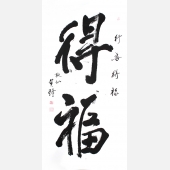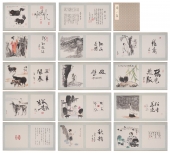Chinese Contemporary Gallery Present New Works by Huang Rui and Zhang Dali
2011-04-15 12:22:53
Chinese Contemporary Gallery is pleased to present new works by Huang Rui and Zhang Dali in its September/October 2007 exhibition, Individual Eras. Works in this exhibition grapple with the concept of how the individual functions within different socio-political eras as well as how the individual as artist, intellectual, friend and citizen responds and functions within the limitations of and the parameters set by the state.
Huang Rui is an artist whose works often touch upon politically sensitive and deeply unsettling political realities within contemporary China. In particular, the artist is fascinated by the ways in which thought, once turned into written text, can be manipulated by individuals, institutions and governments. It is against this backdrop that Huang Rui has produced Slogan, Period, Signboard and Word/Color series – Red Word, White Word, Red Thing, White Thing, both of which are currently on exhibit at Chinese Contemporary Gallery. Slogan, Period, Signboard is composed of six wooden panels and carved into the panels are arguably the most recognizable and politically significant slogans of the past 60 years. Each marks an era in China’s post-1949 history and the artist has, fittingly, crafted the first three panels, or the first 30 years of PRC history, in red, with the final three panels, or post-Deng Xiaoping China, in gold. The slogans are fittingly book ended by the global Communist call to arms in the 1950s, “Workers of the World Unite!” and end with the words of Hu Jintao, “Harmonious Society, Harmonious Asia.” Beautifully executed and meticulously carved, Slogan, Period, Signboard traces China’s recent political history while visually and textually depicting the wide gaps between official rhetoric and reality. Similarly, Color/Word series – Red Word, White Word, Red Thing, White Thing addresses China’s changing economic environment through the use of words and the economic systems that those phrases encompass. Here, Huang Rui also makes use of color to emphasize good and bad and new and old.
Zhang Dali, like Huang Rui, is concerned with the ways in which the state and its policy catalyze social change and influences individuals live. Since his early graffiti and photographic works, Zhang Dali’s works have been concerned with the vast social and cultural changes that occurred since the initiation of economic reforms in 1980. As an artist who sees the “function of the [sic] to present the ills of society,” his work is focused on presenting China’s powerless, and it is out of this mindset that Zhang Dali first began producing his AK-47 series, which is composed of paintings in which the repetition of the mark, AK-47, defines the features of a human face. The individuals depicted in Zhang Dali’s AK-47 portraits, three of which are currently on exhibition at Chinese Contemporary Gallery, are migrant workers, who now account for 400 million Chinese and who flock to China’s booming cities in search of work and higher wages. Because they are poor, dirty and uneducated, they are, at best, ostracized in their new environment and, more commonly, are subject to massive discrimination and oppression. They are China’s faceless mass and Zhang Dali in his AK-47 works seeks to give them a humanizing identity. To the artist, AK-47 is the only symbol that appropriately conveys the scale of the violence that the state inflicts upon the individual. These works are an important chronicle of the times inasmuch as they are an important product of an entirely unique time in China’s social, political and cultural history.
Huang Rui and Zhang Dali present unique works focused on the social and political changes that have occurred during China’s recent history. Huang Rui addresses the ideological and political incongruities of Chinese political policy over the past 60 while Zhang Dali’s works discuss the human implications of China’s rapid socio-economic and political change. Individually, their works represent a distinct time period in China’s recent social history, whether that is class struggle during Great Proletarian Cultural Revolution or the uncertainty of a migrant worker’s life. Moreover, these works also are one individual’s effort to creatively and visually represent the juxtapositions, hypocrisies and injustices that are present in their every day lives.
Chinese Contemporary is pleased to present the works of Huang Rui and Zhang Dali in Individual Eras from 1 September to 14 October.

 黄琦
黄琦 武中奇
武中奇 测试用艺术
测试用艺术 尼玛泽仁
尼玛泽仁
